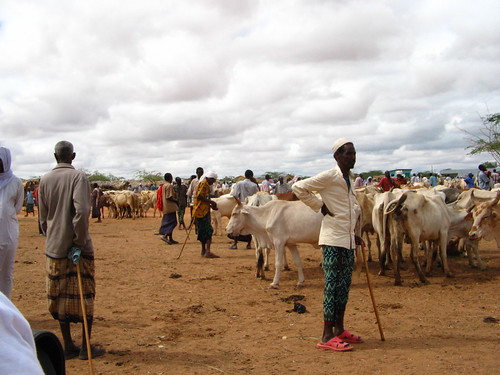
Thirteen year-old Damte Yeshitella tends cattle on the outskirts of Addis Ababa. Improved systems of raising and selling sheep and goats can increase production in Ethiopia's large livestock sector. (Photo credit: ILRI)
A new report calls for making better use of Ethiopia’s native livestock resources, expanding livestock export markets and favourable livestock regions to transform the country’s large livestock sector, particularly that of sheep and goats.
Despite Ethiopia’s wealth (in types as well as numbers) of livestock resources, scientists report that national levels of livestock production remain far below expectations. A new working paper, ‘Sheep and goat production and marketing systems in Ethiopia,’ offers strategies for raising those levels. The report is published by a project, ‘Improving Productivity and Market Success (IPMS) of Ethiopian Farmers,’ implemented by the Government of Ethiopia and the International Livestock Research Institute (ILRI).
Although Ethiopians raise vast numbers of small stock—about 25 million sheep and 21 million goats—the nation’s livestock sector continues to underperform. The new report cites a multitude of technical, socio-economic and biological problems constraining the country’s sheep and goat production. These include livestock diseases and parasites, poor-quality feeds, inaccessible livestock inputs and inappropriate methods for delivering extension messages. Inadequate markets, including insufficient access to markets and market information as well as low market prices, also prevent livestock farmers from achieving the great potential their animals offer.
But ILRI researchers Azage Tegegne, Berhanu Gebremedhin and Dirk Hoekstra, among other authors of the report, are quick to point out that the Ethiopian livestock sector has many ‘favourable opportunities to increase sheep and goat productivity.’
The report recommends supporting alternative production systems that will not only improve small-scale production systems but also speed development of larger scale specialized sheep and goat production systems.
Small stock production should be stratified, the scientists say, and different zones delineated for different kinds of production systems. The report says, for example, that herding and other forms of extensive livestock-based systems are more suited to the country’s vast western, eastern and southern lowlands as well as subalpine sheep-based regions, whereas intensive market-oriented systems are better suited to the wet highlands, where farmers typically mix crop growing with animal husbandry.
Among the places where the Improving Productivity and Market Success of Ethiopian Farmers project is working to increase productivity of small animal stock is Gomma District, where sheep fattening cycles have been set up and are run by women.
The project is enabling farmers to increase the production of sheep and goats, with larger numbers of healthier animals fetching higher prices when they (or their related products) are sold in markets.
‘Farmers are using the increased income to expand and increase the numbers of animals in the fattening program and to purchase agricultural inputs like seeds, fertilizer and farm tools. Household items, especially food, are also more accessible. They are also able pay for their children’s education’, said Tegegne, who is also a research scientist with the project.
Findings from the project in Gomma show that households made a profit of Birr 2,250–4,500 (US$167–333 USD) annually from the sale of fattened animals. In the first round, 120 farmers (38 women) fattened 5 sheep per household in three months. Most managed to fatten 15 sheep in three cycles in a year translating to significant household income for farmers and their families. As a result of this success, the fattening program is now used by more farmer groups and landless urban youths.
‘Women in particular benefit from this project, especially in areas where women’s groups focused on sheep fattening have been established. Fattening activities for small animal stock are traditionally carried out by women, who use income generated from this project to meet household and family needs. There is great potential to expand the project,’ says Tegegne.
The report also recommends greater use of technological interventions to better exploit the country’s genetic diversity and improve its breeding stock and to better control livestock diseases. And it suggests ways to reorient the country’s livestock extension services for better delivery to livestock keepers. The report says improved markets will depend on more and better-quality infrastructure and market information as well as communities of livestock producers organizing themselves into marketing groups or cooperatives to gain better access to markets and to increase their profit margins.
This report is part of a series of working papers produced by a five-year project funded by the Canadian International Development Agency (CIDA) and implemented by ILRI on behalf of the Ethiopian Ministry of Agriculture and Rural Development.
To read the full report, please visit https://cgspace.cgiar.org/handle/10568/2238 and to find out more, visit Improving Productivity and Market Success (IPMS) of Ethiopian Farmers Project.










